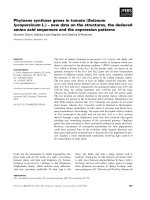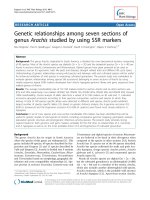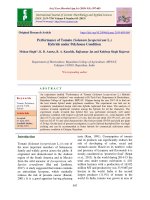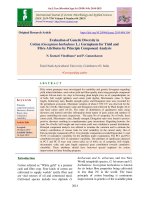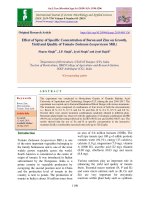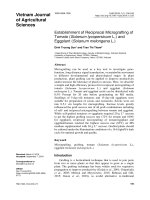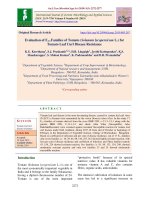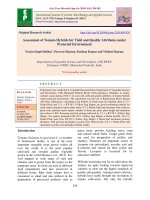Assessment of genetic diversity in hybrids of tomato (Solanum lycopersicum L.) using SSR markers
Bạn đang xem bản rút gọn của tài liệu. Xem và tải ngay bản đầy đủ của tài liệu tại đây (305.02 KB, 6 trang )
Int.J.Curr.Microbiol.App.Sci (2018) 7(3): 946-951
International Journal of Current Microbiology and Applied Sciences
ISSN: 2319-7706 Volume 7 Number 03 (2018)
Journal homepage:
Original Research Article
/>
Assessment of Genetic Diversity in Hybrids of Tomato
(Solanum lycopersicum L.) Using SSR Markers
Vrinda Joshi* and O. Sridevi
Department of Genetics and Plant Breeding, University of Agricultural Sciences, Dharwad,
Karnataka, India
*Corresponding author
ABSTRACT
Keywords
Genetic diversity,
SSR, PIC and
marker
Article Info
Accepted:
10 February 2018
Available Online:
10 March 2018
Molecular diversity analysis on 8 hybrids of tomato generated 27
polymorphic markers. The major allele frequency for the marker SSR123.2 and SSR5-13.1 was least. The polymorphic information content value
(PIC) ranged from 0.00 (SSR1-23.2) to 0.86 (SSR1-62.2) with an average
PIC value of 0.46 per marker indicating more diversity at DNA level.
Alleles ranged from 1-8 per locus with an average of 3.33 alleles per locus.
Cluster analysis resulted into 3 main clusters and 4 subclusters. The diverse
genotypes can be used for hybridization programmes.
Introduction
Tomato is an important and widespread
vegetable in the word as fresh consumption
and processed products. However, narrow
genetic bases have become a bottleneck in the
tomato breeding. Therefore, it is essential to
know the genetic relationship between the
tomato species. Molecular markers are
generally recognized as a reliable means for
the genetic identification among plant
genotypes (Omrani et al., 2007). In the past
decades, all kinds of molecular markers such
as restriction fragment length polymorphisma
(RFLP) (Williams and Clair 1993; Messeguer
et al., 1991), inter-simple sequence repeat
(ISSR) (Tikunov et al., 2003), randomly
amplified polymorphic DNA (RAPD)
(Claudio et al., 2004; Bernardette et al., 2006),
simple sequence repeat SSR (Powell et al.,
1996; He et al., 2003; Jin et al., 2004; Cooke
et al., 2003), and amplified length
polymorphic (AFLP) (Claudio et al., 2004)
have been used to analyze the genetic
relationships among the cultivated tomato
varieties. SSR is one of the powerful DNA
fingerprinting techniques. The objective of the
present study was to analyze the molecular
diversity of tomato hybrids.
Materials and Methods
Eight single cross hybrids were subjected for
molecular diversity analysis. Thirty seven SSR
946
Int.J.Curr.Microbiol.App.Sci (2018) 7(3): 946-951
primers were used for diversity of these
genotypes. The DNA from 15 days old
seedlings was extracted by following mini prerapid method with little modifications (Doyle
and Doyle, 1987). The SSR reaction mixture
consisted of 25-50 ng of template DNA, 2 pM
of Forward and Reverse primer, 2.5 mM of
dNTPs, 1 unit of Taq polymerase (Bangalore
Genei, India), 10X PCR buffer (100mM Tris
pH 9.0, 500 mM KCl, 15mM MgCl2 and
0.1% Gelatin) in a volume of 10 µl.
Amplification was carried out using Master
Thermal Cycler 5331-Eppendorf Version 2.30,
31-09, Germany. The amplification profile
was as follows.
Agarose gel of 2.5 per cent was prepared
using electrophoresis grade agarose (Lonza) in
electrophoresis buffer (1X TAE). After the
run, the gel was viewed under UV light and
the DNA banding pattern was recorded
directly in UV doc.
The products of PCR were scored visually by
comparing with the standard marker of size
100 bp (Bangalore Genie).
Allelic variation was calculated from the
frequencies of genotypes at each locus as the
polymorphic information content (PIC).
Genetic parameters namely major allele
frequency, genotype frequency and PIC were
estimated using the software programme
Power Marker version 3.25 (Liu and Muse,
2005). Dendrogram was constructed using the
neighbourhood-joining algorithm using the
programme DARwin 5.0 (Perrier et al., 2003)
and the per cent polymorphism was calculated
by using the following formula,
Number of polymorphic bands
Per cent polymorphism = ----------------- x 100
Total number of bands
Results and Discussion
Thirty seven SSR primers equally spaced on
different chromosomes of tomato were used
for screening the 8 genotypes. Majority of the
markers amplified a single allele per marker.
The major allele frequency (Table 1) was least
for the marker SSR1-23.2 and SSR5-13.1.
The polymorphic information content value
(PIC) calculated ranged from 0.00 (SSR123.2) to 0.86 (SSR1-62.2) with an average PIC
value of 0.46 per marker. The results revealed
that out of 37 SSR primers screened, 33
markers generated amplicons in the 8
genotypes and 27 markers recorded
polymorphism. Range of alleles per locus was
1-8 with an average of 3.33 alleles per locus.
The amplification profile was as follows
Sl. No.
1
2
3
4
5
6
7
8
9
Steps
Pre-denaturation
Denaturation
Annealing
Extension
Denaturation
Annealing
Extension
Final extension
Hold
Temperature (0C)
Duration
Cycles
95
94
54-61
72
94
54-61
59
72
4
5 Min
1 Min
45 Sec
1 Min
1 Min
45 Sec
45 Sec
10 Min
5 Min
1
7
947
30
1
Until samples are removed
Int.J.Curr.Microbiol.App.Sci (2018) 7(3): 946-951
Table.1 Molecular diversity of number of alleles, allele frequency, gene diversity and
polymorphic information content in eight tomato genotypes
SI.
Number
1
2
3
4
5
6
7
8
9
10
11
12
13
14
15
16
17
18
19
20
21
22
23
24
25
26
27
28
29
30
31
32
33
Marker
SSR1-0.2
SSR1-23.2
SSR1-62.2
SSR1-104.1
SSR1-153.2
SSR2-0.2
SSR2-21.1
SSR2-47.1
SSR2-79.2
SSR2-84.1
SSR2-145.1
SSR3-26.2
SSR3-61.1
SSR3-92.1
SSR3-130.2
SSR3-171.1
SSR4-10.1
SSR4-45.1
SSR4-67.2
SSR4-83.1
SSR4-115.1
SSR4-135.2
SSR5-13.1
SSR5-39.1
SSR5-69.1
SSR5-102.1
SSR5-112.2
SSR6-0.1
SSR6-10.1
TES0312
SSR6-17.1
SSR6-25.2
SSR6-34.1
Mean
Major Allele
Sample
Allele
Gene
PIC
Frquency
0.63
0.13
0.13
0.88
0.38
0.5
0.38
0.75
0.63
0.5
0.88
0.63
0.63
0.88
0.75
0.38
1
0.25
1
1
1
0.75
0.25
0.5
1
0.5
0.38
0.25
0.25
0.25
0.5
0.38
0.5
0.57
Size
8
8
8
8
8
8
8
8
8
8
8
8
8
8
8
8
8
8
8
8
8
8
8
8
8
8
8
8
8
8
8
8
8
8
No
2
8
8
2
3
3
3
2
2
4
2
2
2
2
2
4
1
5
1
1
1
3
7
3
1
3
4
6
6
7
3
4
3
3.33
Diversity
0.47
0.88
0.88
0.22
0.66
0.63
0.66
0.38
0.47
0.66
0.22
0.47
0.47
0.22
0.38
0.72
0
0.78
0
0
0
0.41
0.84
0.63
0
0.59
0.72
0.81
0.81
0.84
0.59
0.69
0.59
0.5
0.36
0.86
0.86
0.19
0.58
0.55
0.58
0.3
0.36
0.6
0.19
0.36
0.36
0.19
0.3
0.67
0
0.75
0
0
0
0.37
0.82
0.55
0
0.51
0.67
0.79
0.79
0.82
0.51
0.63
0.51
0.46
Table.2 Cluster distribution of eight tomato genotypes based on molecular diversity
Main cluster
A
B
Sub cluster
I-A
II-A
I-B
II-B
Number of genotypes
3
1
2
2
948
Cluster composition
TSH-4, TSH-5, TSH-8
TSH 1
TSH-3, TSH-6
TSH-2, TSH-7
Int.J.Curr.Microbiol.App.Sci (2018) 7(3): 946-951
FIG 1
949
Int.J.Curr.Microbiol.App.Sci (2018) 7(3): 946-951
The 8 genotypes were divided into three main
clusters (Table 2) A and B which further
formed 4 sub clusters. Among the two main
clusters, Cluster A formed 2 sub clusters in
which Clusters I-A had three genotypes, while
Cluster II-A was solitary with one genotype in
it. Main Cluster B had 2 sub clusters and
among them, Cluster I-B and Cluster II-B had
two genotypes each having two genotypes
(Fig. 1).
2004. Identification of PCR-based
markers (RAPD, AFLP) linked to a
novel powdery mildew resistance gene
(0l-2) in tomato. Plant Science. 166, 4148.
Cooke R J, Bredemeijer G M M, Ganal M W,
Peters R, Isaac P, Rendell S, Jackson J,
Röder M S, Korzun V, Wendehake K,
et al., 2003. Assessment of the
uniformity of wheat and tomato
varieties at DNA Microsatellite loci.
Euphytica, 132, 331-341.
Doyle, J. J. and Doyle, J. L., 1987. A rapid
DNA isolation procedure for small
quantities of fresh leaf tissue.
Phytochemical Bulletin. 19: 11-15.
Ezekiel, C. N., Nwangburuka, C. C., Ajibade,
O. A. and Odebode, A. C., 2011.
Genetic diversity in 14 tomato
(Lycopersicon
esculentum
Mill.)
varieties in Nigerian markets by RAPDPCR technique. African J. Biotechnol.
10(25): 4961-4967.
He, C., Poysa, V. and Yu K., 2003.
Development and characterization of
simple sequence repeat (SSR) markers
and
their
use
indetermining
relationships
among
Lycopersicon
esculentum cultivars. Theoretical and
Applied Genetics. 106, 363-373.
Jin, F. M., Xue, J., Xia, S. Y. and Liu, Z. Q.,
2004. Application of SSR marker
technique to the tomato genetic
breeding. Tianjin Agricultural Sciences.
4, 13-17. (in Chinese)
Liu, K. and Muse, S. V., 2005. Powermarker:
Integrated analysis environment for
genetic marker data. Bioinform. 21:
2128-2129.
Messeguert, R., Ganal, M., de Vicente, M. C.,
Young, N. D., Bolkan, H. and Tanksley,
S. D., 1991. High resolution RFLP map
around the root knot nematode
resistance gene (Mi) in tomato.
Theoretical and Applied Genetics. 82,
529-536.
Range of 1-8 alleles per locus with an average
of 3.3 alleles per locus was observed. Similar
PIC value range, allele number and allelic
frequency in tomato were reported by Ezekiel
et al., (2011) and Saida et al., (2013) with
various markers. The results of hierarchical
clustering in this study grouped the accessions
into two main clusters, ‘A’ and ‘B’ and these
were divided into four sub-clusters. However,
the cluster analysis in the present study
indicated wide range of variability at
genotypic level. The polymorphism at
genotypic level can be assessed by generating
high polymorphic markers. High resolution of
markers is needed for characterization and
evaluation which can be done by increasing
the number of repeat units and length of the
marker. When compared with clusters formed
through D2 analysis no single genotype was
common between them indicating that
phenotypic diversity is not associated with
genotypic diversity.
References
Bernardette, P. C., Gerald, L. T. S.,
Grazziotin, F. G. and Echeverrigaray,
S., 2006. Genetic diversity among
Brazilian cultivars and landraces of
tomato Lycopersicon esculentum Mill.
Revealed by RAPD markers. Genetic
Resources and Crop Evolution. 53, 395400.
Claudio, D. G., Pasqua, D. O., Angela, B.,
Franco, C., Concetta, L. and Luigi, R.,
950
Int.J.Curr.Microbiol.App.Sci (2018) 7(3): 946-951
Perrier, X., Flori, A. and Bonnot, F., 2003.
Data analysis methods, Science
Publishers, Montpellier, pp. 43-76.
Powell, W., Machray, G. C. and Provan, J.,
1996. Polymorphism revealed by simple
sequence repeats. Trends Plant Science.
1: 215- 222.
Saida, S., Sabina, M., Konstantinos, T. and
Konstantinos, R., 2013. Assessment of
genetic diversity in cultivated tomato
(Solanum lycopersicum L.) genotypes
using RAPD primers. J. of Horticultural
Research. 21(1): 83-89.
Tikunov, Y. M., Khrustaleva, L. I. and
Karlov, G. I., 2003. Application of
ISSR
markers
in
the
genus
Lycopersicon. Euphytica. 131, 71- 80.
Williams, C. E. and Clair, D. A. S., 1993.
Phenetic relationships and levels of
variability detected by restriction
fragment length polymorphism and
random amplified polymorphic DNA
analysis of cultivated and wild
accessions of Lycopersicon esculentum.
Genome. 36, 619-630.
How to cite this article:
Vrinda Joshi and Sridevi, O. 2018. Assessment of Genetic Diversity in Hybrids of Tomato
(Solanum lycopersicum L.) Using SSR Markers. Int.J.Curr.Microbiol.App.Sci. 7(03): 946-951.
doi: />
951
